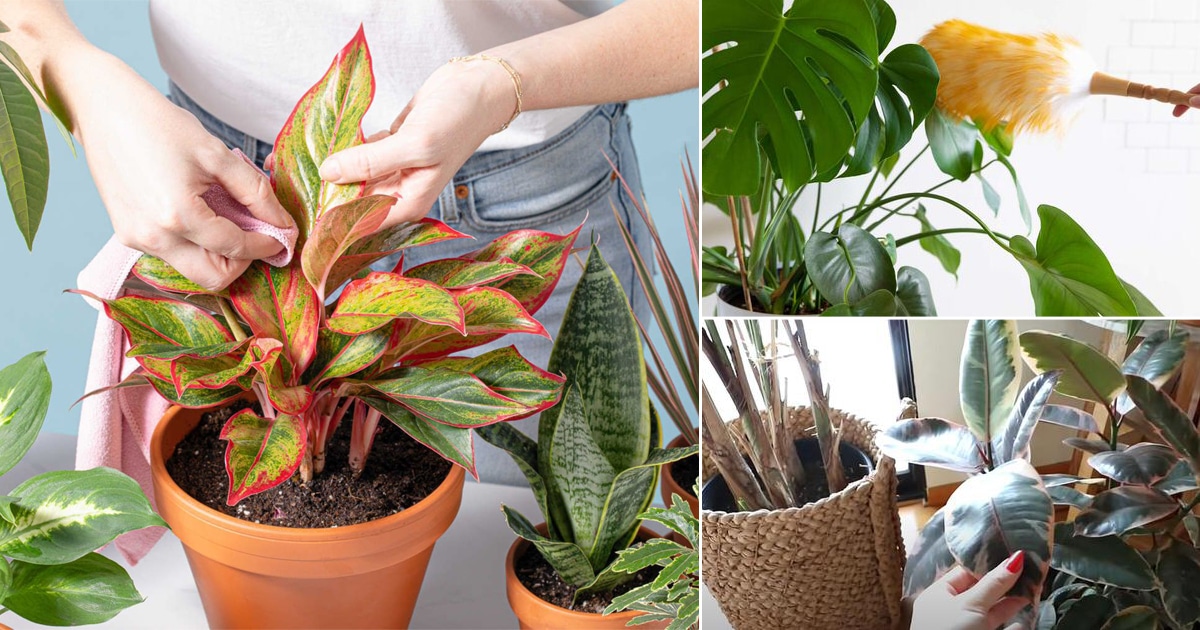Do you want to discover the most effective methods for keeping the leaves of your indoor plants looking fresh and healthy? Learn 10 Easy Ways to Keep Your Houseplants Clean!
Dusty indoor plants are not only ugly and obscure the show of vibrant foliage, but they also make it difficult for the plant to photosynthesize. Here are some of the most crucial Basic Tips for Cleaning Your Houseplants so that they always look their best and stay healthy!
The Right Time

Dirt collects on the leaves of houseplants, especially if they are kept near a window or entrance. If you reside in a polluted location, your plants will be subjected to dusty coverings on a regular basis.
You may keep track of your houseplant’s dusting requirements by running your fingertips on the leaves every 5-8 days to determine whether it needs to be cleaned. It’s a must if you want to boost your houseplants’ photosynthetic rate!
Spray with Water

Giving houseplants like aloe and crown of thorns a shower bath is the easiest method to clean them. Keep an eye on the water pressure because it has the potential to wash the growing medium out of the pot.
Also, make sure that all of the extra water drains out of the drainage hole at the bottom of the pot.
Cleaning the plants’ leaves in the morning and then leaving them in direct morning sunshine for 3-4 hours is a good idea.
Dust Leaves Using a Feather Duster

If there is only a small coating of dust on your houseplant, a feather duster can be used to remove it. This should be done every 3-4 days to keep the dust from creating a heavy coating on the leaves.
The best are ostrich feathers, which can trap dust much better than any other similar product.
Use Pressure Air

Pressure air is an excellent technique to keep dust particles off of plants with dense foliage, such as cacti and succulents. You may use compressed air or a camera sensor air cleaner to clean the sensor. Make an air compressor out of a plastic bottle .
Dunk Plants in Water

This strategy is only suitable for little plants or air plants that are partially pot-bound. Dunk the leaves in a bucket of water while holding the pot. This will just water the leaves, preventing the growth medium from becoming too saturated.
To avoid dry soil pouring from the inverted container, moisten the soil a little first.
Wiping the Leaves

For many popular houseplants, wiping the dust off the leaves is the best solution. This approach may be used to clean indoor plants with fewer and larger leaves, such as fiddle leaf figs, dieffenbachias, and snake plants.
Wipe each leaves with a moist soft cotton towel while supporting them from the bottom.
Use a Mild Soapy Mix if Your Plants are Too Dirty

If your plants appear to be heavily soiled or have a mite infestation. This is an excellent method: directly spray a diluted soap solution on the leaves and wipe them clean.
Add 1/4 teaspoon dish soap to 500 mL RO water to make a soapy solution.
Make sure the soap solution is thoroughly removed from the leaves.
Prune Yellow and Brown Leaves

Remove any brown, yellow, dead, or loose leaves and stems while cleaning your houseplants. Snip them away with a pair of clean, sharp scissors. The plants will be neater as a result of this.
Clean Containers

Cleaning the pots while cleaning the plants is a good idea since a clean plant will not look nice in a filthy container!
Clean the pots using a solution of bleach and water. To provide a good massage, use a brush.
Tip: Wear good-quality gloves the entire time you’re cleaning.
Keep the Soil Clean

Remove any undesirable weeds from the soil surface, and continue to aerate the top layer of the soil by gently rotating it once in a while to promote air circulation and assist your houseplant breathe.

